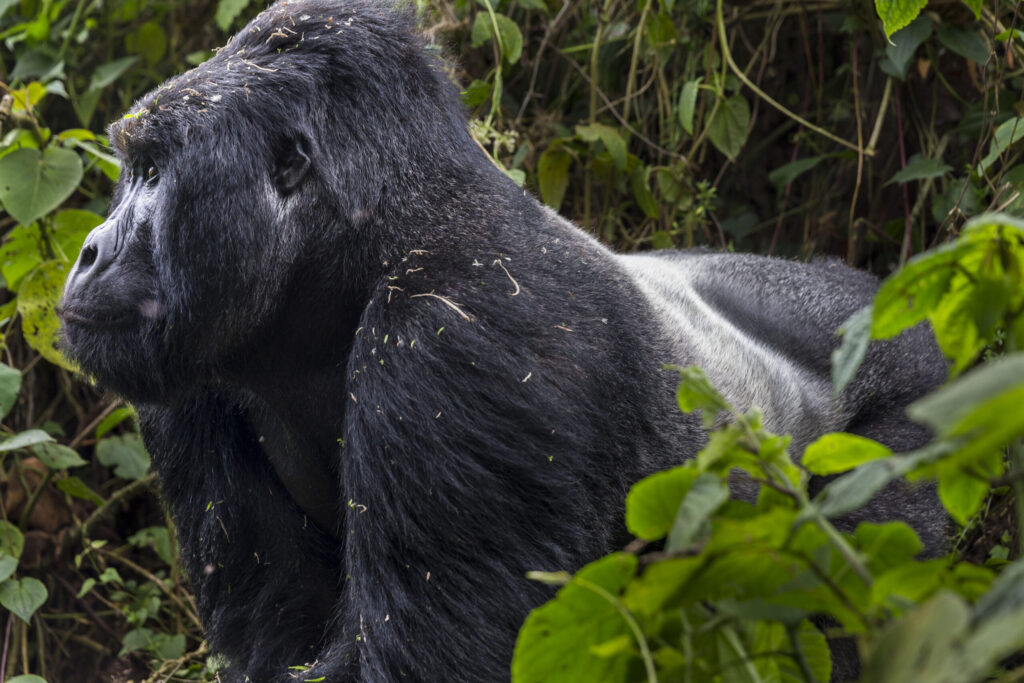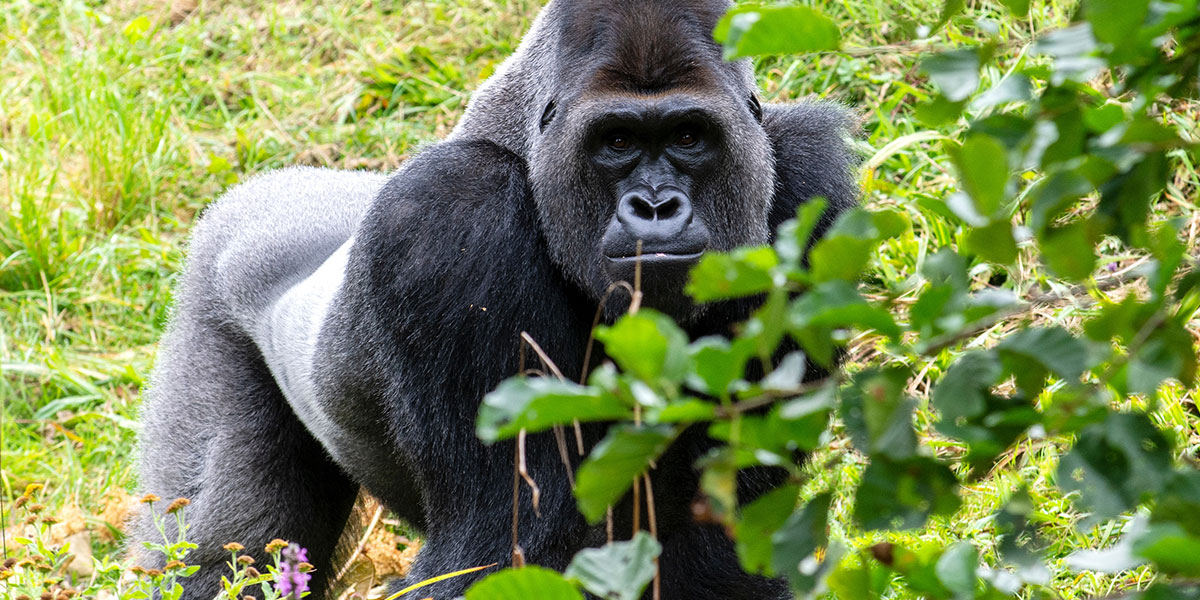Adult male silverback mountain gorilla
Adult male silverback mountain gorilla, Adult male silverback mountain gorilla is distinguished by the band of silver hair on its back. In addition to this notable indicator of maturity, they are renowned for exhibiting aggression and dominance through behaviors such as whooping, charging, chest beating, tree slapping, and, less frequently, physical confrontations.
A typical silverback weighs 195 kilograms (430 pounds) and measures 1.5 meters (5 feet) in height. Silverbacks possess remarkable strength, capable of lifting in excess of 1,763 pounds (800 kg) of dead weight. That is approximately double the amount of a proficient weightlifter. In the wild, a silverback employs its considerable strength to uproot trees to access their fruits. Mountain gorillas are a keystone species in Virunga, as they profoundly influence the ecology of their habitat.

What prompts a silverback to charge?
Typically, dormant silverback gorillas charge, thumping their chests and emitting roaring sounds. This could constitute a form of play, an effort to intimidate, or merely a notification to the group regarding an anomaly or the initiation of an interaction. When the silverback gorillas engage in this behavior, the adult females, juveniles, and infants nearby cluster together, positioning their bellies against the ground and tucking their feet and hands beneath their bodies. This is performed to demonstrate their submission to the silverback.
The Dominant Silverback
A male gorilla reaches silverback status at approximately fourteen years of age. While a troop may contain several silverbacks, there is invariably one male that asserts dominance over all other gorillas, except in rare cases of matriarch-led troops. In Virunga National Park, habituated families are typically named after the silverback leading the troop at the onset of the habituation process, a conservation method that acclimatizes gorilla families to close human interaction.
The Relationship Between Silverback Males and Females
Adult females frequently migrate among families to enhance reproductive opportunities and prevent inbreeding. Regardless of the family to which a female belongs, she will endeavor to maintain close proximity and a robust connection with the dominant silverback. This mitigates harassment from other males and diminishes the risk of hostility from unrelated females encountered during migration.

Blackbacks and Subordinate Silverbacks
Internal conflicts among silverbacks typically manifest as displays of aggression rather than physical confrontation. Nonetheless, altercations transpire, occasionally resulting in fatalities. Coalitions may result in subordinate males obstructing females from migrating during confrontations with competing troops. While it may seem that the subordinate silverback is safeguarding the dominant silverback’s position, his actual motivation is to maintain access to the females in the troop, aspiring to eventually usurp the dominant silverback. An alternative to coalition formation or dominance challenges is for a silverback to adopt a solitary existence.
Behavioral Attributes and Qualities of Adult Male Silverback Gorillas
Although they are formidable mammals, silverback gorillas exhibit shyness and gentleness. They inhabit groups consisting of 10 to 30 individuals. An adult silverback functions as the alpha and leader of the group. In addition to safeguarding the troop, the alpha silverback also directs their movements for travel, foraging, and resting. During confrontations with other animals, silverbacks assume an upright posture on their hind legs, uproot and hurl vegetation, stomp their feet, and beat their chests with their hands.
Gorillas are nomadic, allowing them to construct new nests daily. A troop consisting of multiple younger males, adult and juvenile females, and infants. Regarding reproduction, the silverback in the group is the sole male gorilla permitted to mate with all the females in a troop. Due to the silverback’s size and strength, females prefer to mate with him over other males in the gorilla group.
Upon attaining sexual maturity, male gorillas opt to depart from the troop and live solitarily until they can establish their own troop to lead.
Similar to other prominent primates, silverbacks are astute apes. They can also convey messages through vocalization, gestures, facial expressions, and body language.
Upon the mother’s demise within the group, the silverback will assume responsibility for the juveniles and permit them to rest in his nest. Gorillas are generally reserved and timid; they retreat unless an intruder challenges a silverback to usurp the group.
Conflicts are predominantly resolved through demonstration rather than confrontation. The silverback tends to his group and rests at midday, often sleeping for nearly 13 hours. During this period, they may engage in play, grooming, and foraging with troop members.
The Threats Faced by Mountain Gorillas: Conservation Status
According to the IUCN Red List, mountain gorillas are classified as an endangered species due to the following reason:
They confront habitat loss resulting from human encroachment. Poaching frequently occurs in regions inhabited by gorillas, where poachers illegally kill them for the bushmeat trade. The conservation initiative has been implemented to protect these critically endangered mountain gorillas by collaborating with stakeholders capable of preserving their habitat. In addition to essential information regarding a silverback, the following are supplementary facts about mountain gorillas:
Female mountain gorillas attain sexual maturity and the capacity to reproduce at the age of ten. Following an 8.5-month gestation period, female gorillas typically deliver a solitary offspring. Typically, individuals give birth to between two and six offspring over their lifetime. Female mountain gorillas experience an interbirth interval of 4 to 5 years prior to delivering another offspring.
Neonatal gorillas exhibit fragility akin to that of human infants. They can be weaned at three and a half years and typically remain close to their mothers until the age of four. Currently, they may be subsisting on an identical diet comprising plants, fruits, and shoots.
Gorillas infrequently consume water, instead obtaining hydration primarily through the ingestion of succulent vegetation and fruit. They can recognize their group members by their nose prints, which is also a fact about Silverback Gorillas. Gorillas resemble humans in possessing 32 teeth, albeit with notably sharp canines. When agitated, silverbacks possess substantial apocrine glands in their axillary regions that secrete a strong odor.
Ultimately, the Silverback gorilla is a distinctive species that oversees all group activities, and the optimal way to appreciate its remarkable nature is to organize a trip to one of the following gorilla safari destinations: Uganda’s Bwindi Impenetrable Forest National Park, Rwanda’s Volcanoes National Park, and Congo’s Virunga National Park.
